Novel yellow thermally activated delayed fluorescence emitters for highly efficient full-TADF WOLEDs with low driving voltages and remarkable color stability†
Abstract
White organic light-emitting diodes (WOLEDs) based on all thermally activated delayed fluorescence (TADF) emitters are especially attractive due to the merits of high efficiency and low cost. Novel TADF emitters (TFM-QP and CN-QP) were developed by selecting 6-(trifluoromethyl)quinoxaline or 6-(cyano)quinoxaline as the electron acceptor and phenoxazine as the electron donor. Aggregation induced emission is detected. Small singlet and triplet energy splitting values of 0.03–0.04 eV and long fluorescence lifetimes of 1.6–5.0 μs confirm their TADF nature. The chromaticity of monochromic OLEDs with TFM-QP and CN-QP as doped emitters was adjustable from yellow to orange–red by varying the doping concentration, and the yellow OLEDs exhibit external quantum efficiencies (ηext) of 14.4% and 9.7% at a low doping level. Full-TADF WOLEDs were fabricated using TFM-QP or CN-QP in combination with the sky-blue TADF emitter DMAC-DPS. The single-emitting-layer doped warm-white OLED (CN-QP:DMAC-DPS) exhibits excellent performance with a low turn-on voltage of 2.8 V, a stable color rending index (CRI) of 72, and high efficiencies of 48.22 cd A−1, 50.47 lm W−1, and 20.16%, which should be the highest efficiency records ever reported for full-TADF warm-white OLEDs so far. The non-doped full-TADF WOLED with an emitting layer structure of DMAC-DPS/TFM-QP/DMAC-DPS achieves a high CRI of 86 and a moderate ηext of 8.7%.



 Please wait while we load your content...
Please wait while we load your content...